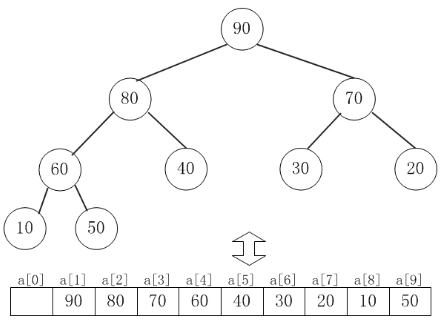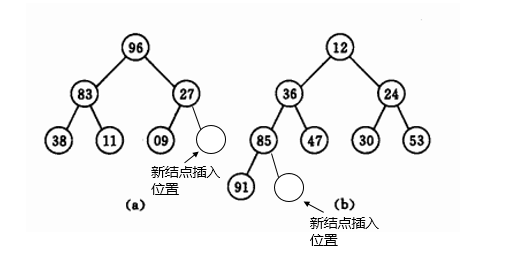数据结构--二叉堆
二叉堆是完全二元树或者是近似完全二元树,按照数据的排列方式可以分为两种:最大堆和最小堆。
最大堆:父结点的键值总是大于或等于任何一个子节点的键值;最小堆:父结点的键值总是小于或等于任何一个子节点的键值。示意图如下:
二叉堆一般都通过"数组"来实现。数组实现的二叉堆,父节点和子节点的位置存在一定的关系。有时候,我们将"二叉堆的第一个元素"放在数组索引0的位置,有时候放在1的位置。当然,它们的本质一样(都是二叉堆),只是实现上稍微有一丁点区别。
假设"第一个元素"在数组中的索引为 0 的话,则父节点和子节点的位置关系如下:
(01) 索引为i的左孩子的索引是 (2*i+1);
(02) 索引为i的右孩子的索引是 (2*i+2);
(03) 索引为i的父结点的索引是 floor((i-1)/2);

假设"第一个元素"在数组中的索引为 1 的话,则父节点和子节点的位置关系如下:
(01) 索引为i的左孩子的索引是 (2*i);
(02) 索引为i的右孩子的索引是 (2*i+1);
(03) 索引为i的父结点的索引是 floor(i/2);

二、二叉堆的操作
堆一般使用数组来构建,假设为数组a[],结点通常存储在a[1],这样对于下标为k的结点a[k]来说,其左孩子的下标为2*k,右孩子的下标为2*k+1。
1、插入结点到堆中.
由于小根堆是由数组实现的完全二叉树,所以插入的位置应该是完全二叉树的最后一个位置(如下图所示),对于小根堆来讲,需要满足两个性质:(1)堆为完全二叉树;(2)堆中每个结点的值都不大于其左右结点的值。插入结点可能会破坏这两条性质,所以在插入结点后需要对堆进行调整。调整方法为:将插入的结点与其父结点比较,若小于其父结点的值,则交换两者。重复此操作,直至该结点不比其父结点小,或者该结点成为根结点。可以通过插入结点到一个已经存在的堆中,也可以通过不断插入结点来构建一个堆。

2、删除堆顶元素(堆排序)
删除堆顶元素(根结点)后,会得到左右两棵子树,此时将堆中最后一个元素移到堆顶,然后自上而下调整,将该结点与左右孩子结点比较,此时会有三种情况:
(1)结点的左右孩子均为空,此时调整结束;
(2)结点只有左孩子,此时将该结点与其左孩子比较。若结点大于其左孩子,则两者交换,否则调整结束;
(3)结点左右孩子都非空,则将该结点与左右孩子之间的较小者比较,若小于则交换,否则调整结束;
重复此过程,直到该结点不大于其左右孩子结点,或者该结点为叶子结点。
/*
对于二叉堆,介绍以下几种操作:
插入节点;
上浮节点;
删除节点;
下沉节点;
构建二叉堆;
C++中的STL库中可以实现,这一功能简化了自己手写模板的麻烦,增加了运用的方便。
例如一个程序:
就可以实现对于二叉堆挥着队列中的元素进行排序选择最大的元素。
#include <iostream>
#include <queue>
#include <algorithm>
using namespace std;
priority_queue<int> q;
int main()
{
q.push(1);
q.push(2);
q.push(3);
cout<<q.top()<<endl;
return 0;
}
那么这么好用的东西,那么细致学习一下。
对于优先队列有几个基本的操作:
empty() 如果队列为空返回真
pop() 删除对顶元素
push() 加入一个元素
size() 返回优先队列中拥有的元素个数
top() 返回优先队列对顶元素
在int类型中默认的是大顶堆, 也就是top()处来的第一个元素是队列中最大的。
使用方法:
头文件:
#include <queue>
声明方式:
1、普通方法:
priority_queue<int> q; //q表示的是队列的名字
//简单使用
#include <iostream>
#include <queue>
#include <algorithm>
using namespace std;
priority_queue<int> q;
int main()
{
q.push(1);
q.push(2);
q.push(3);
cout<<q.top()<<endl;
return 0;
}
//自己定义结构体
//最小值优先, x小的优先级高
//声明是
priority_queue<int, vector<int>, cmp> q;
//第一个是优先队列的类型, 第二个为容器的类型, 第三个是标胶函数
//小顶堆
struct cmp
{
bool operator()(int x, int y)
{
return x > y;
}
};
//大顶堆
struct cmp
{
bool operator()(int x, int y)
{
return y > x;
}
};
2、优先级定义
//例如下面的程序
#include <iostream>
#include <algorithm>
#include <queue>
using namespace std;
struct cmp
{
bool operator()(int x, int y)
{
return y > x;
}
};
int main()
{
priority_queue<int, vector<int>, cmp> q;
q.push(1);
q.push(51);
q.push(12);
q.push(331);
q.push(12);
cout<<q.top()<<endl;
return 0;
}
3、结构体声明方式:
//定义方法:
prioritry_queue<node >q;
//结构体中,x小的优先级高
struct node
{
int x, y;
friend bool operator < (node a, node b)
{
return a.x > b.x;
}
};
*/
#include <algorithm>
#include <iostream>
using namespace std;
class MinHeap
{
private:
int* heap; //存储堆
int cur; //堆中结点个数
/*插入结点后,向上调整*/
void adjustUp();
/*删除结点后,向下调整*/
void adjustDown(int idx);
public:
MinHeap();
~MinHeap();
/*插入值为val的结点*/
void insert(int val);
/*返回最小值并删除最小值结点*/
int deleteMin();
};
MinHeap::MinHeap()
{
heap = new int[20];
cur = 0;
}
MinHeap::~MinHeap()
{
delete[] heap;
}
/*插入值为val的结点*/
void MinHeap::insert(int val)
{
heap[++cur] = val;
adjustUp();
}
/*插入结点后,向上调整*/
void MinHeap::adjustUp()
{
int idx = cur;
int pIdx = cur / 2;
while (pIdx > 0 && heap[idx] < heap[pIdx])
{
swap(heap[idx], heap[pIdx]);
idx = pIdx;
pIdx = pIdx / 2;
}
}
/*返回最小值并删除最小值结点*/
int MinHeap::deleteMin()
{
int minVal = heap[1];
heap[1] = heap[cur--];
adjustDown(1);
return minVal;
}
/*删除结点后,向下调整*/
void MinHeap::adjustDown(int idx)
{
if (idx > cur)
return;
int lIdx = idx * 2;
int rIdx = idx * 2 + 1;
int minIdx = 0;
if (lIdx > cur) //无左右孩子
return;
else if (rIdx > cur) //只有左孩子
minIdx = lIdx;
else minIdx = heap[lIdx] < heap[rIdx] ? lIdx : rIdx; //左右孩子均非空
if (heap[idx] > heap[minIdx])
{
swap(heap[idx], heap[minIdx]);
adjustDown(minIdx);
}
else return;
}
int main()
{
int a[] = { 5, 1, 3, 4, 2 };
int len = sizeof(a) / sizeof(a[0]);
/*插入结点构造最小堆*/
MinHeap* minHeap = new MinHeap();
for (int i = 0; i < len; i++)
minHeap->insert(a[i]);
/*输出堆顶结点的值*/
for (int i = 0; i < len; i++)
cout << minHeap->deleteMin() << " ";
cout << endl;
return 0;
}



 浙公网安备 33010602011771号
浙公网安备 33010602011771号